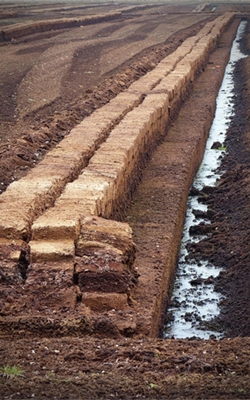This soil sampler for solution sampling is specifically designed to extract soil solutions from soil for analysis of nutrients, salts, pH values, or other dissolved substances. It sucks the solution from the surrounding soil through a porous ceramic head or other permeable material, and then collects the solution into a container through a connected vacuum device or negative pressure pipeline.

Specially designed for solution sampling
- The soil sampler for solution sampling uses chemically inert materials such as ceramic cups or polytetrafluoroethylene (PTFE) to avoid contamination of the sample and ensure the representativeness and accuracy of the collected solution.
- It has a simple structure and is often equipped with a syringe or vacuum pump to apply negative pressure to collect solutions. The operation process is safe and efficient.
- The soil sampler for solution sampling is able to achieve continuous monitoring is beneficial for studying the long-term migration patterns of water-soluble nutrients or pollutants.

Reusable, lower cost
- Some models can be reused for easy cleaning and maintenance, reducing long-term usage costs.
- The soil sampler for solution sampling is able to achieve continuous monitoring, which is beneficial for studying the long-term migration patterns of water-soluble nutrients or pollutants.
- It can be used continuously or reused in different locations. No need to take soil for decomposition, no need to damage the on-site structure.
Applications
A soil sampler is widely used in agriculture, environmental monitoring, and geotechnical analysis. It is ideal for sampling in wetlands, tidal flats, and can collect soils such as marsh, peat, and sediment. The sampler helps assess soil health, nutrient levels, and pH in agriculture, detects contamination in environmental studies, and evaluates soil stability in construction projects. It also supports research, land reclamation, and conservation by providing insights into soil quality and promoting sustainable land management.

River

Peat Soil

Lake

Tidal Flat
| Model | SISCO-SS-JCTRSW |
| Ceramic Head | Diameter 31 millimeters, length approximately 7cm |
| Large Ceramic Head | 31mm |
| Sampling Length | 15cm, 30cm, 45cm, 60cm, 90cm, 120cm |
| Depth | 15m |
Q1: What is a soil sampler for solution sampling used for?
A1: It is designed to collect soil pore water (soil solution) for chemical analysis, such as testing for nutrients (e.g., nitrates, phosphates), pH, salinity, or contaminants. The sampler can be left in place for long-term monitoring or removed and relocated. Repeated use requires proper cleaning to avoid cross-contamination.
Q2: What is the ideal depth range for sampling?
A2: Most models allow sampling from 15 cm to 90 cm depth, depending on probe length and soil conditions. Deep samplers can access root zone solutions effectively. Sampling frequency depends on the application. For nutrient monitoring, weekly or bi-weekly sampling may be appropriate. Environmental studies may follow different intervals.
Q3: How does this type of soil sampler for solution sampling work?
A3: The sampler is inserted into the soil at the desired depth. A vacuum is applied to draw soil solution through a porous ceramic tip or membrane into a collection chamber or tube. Collected samples are not sterile. If sterile or particle-free samples are required, additional filtration or sterilization steps must be performed after collection.
Tips: Instructions for using the soil sampler for solution sampling:
- The suction-type soil solution sampler can be buried at any location, with a maximum depth of up to 15 meters.
- Choose appropriate sampler lengths as needed and possible, typically 15 cm, 30 cm, 45 cm, 60 cm, 90 cm, and 120 cm.
- The ceramic head has a diameter of 31 millimeters and a length of about 7 cm. Drill a hole with a diameter of 32 mm and a suitable depth at the location where the soil solution needs to be extracted, and insert the sampler vertically into the hole, paying attention to leaving a surface height.
- Use a water stop (gas) ring to clamp the water outlet rubber pipe and seal it.
- When extracting the solution, insert the manual air pump interface into the air pressure pipe port and release the water stop ring of the water outlet pipe. Inject positive air pressure into the air pressure pipe and place a pre-prepared container below the water outlet rubber pipe. When the air pressure reaches a certain level, the solution will automatically flow out.
Thank you for buying industrial test and measurement equipment on SISCO.com, all products sold by SISCO and the partner cover a 12 months warranty, effective from the date of receiving the products.
What is covered?
SISCO is responsible for providing free spare parts, and free technical support to assist the customer to repair the defective products until the problem is solved.
What is not covered?
- Product purchased from anyone other than a SISCO store or a SISCO authorized reseller.
- Expendable parts.
- Routine cleaning or normal cosmetic and mechanical wear.
- Damage from misuse, abuse or neglect.
- Damage from use of parts other than SISCO approved.
- Damage from use outside the product’s usage or storage parameters.
- Damage from use of parts not sold by SISCO.
- Damage from modification or incorporation into other products.
- Damage from repair or replacement of warranted parts by a service provider other than a SISCO authorized service provider.
- Damage caused by the application environment not meeting the product usage requirements and the failure to perform preventive maintenance.

